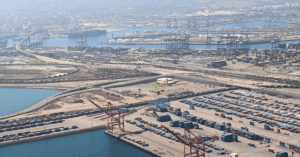
5-Star Cruise Ship Deployed By Mano Maritime To Evacuate Israelis From Cyprus
June 17, 2025
Oil Tankers Collide & Catch Fire Near Strait Of Hormuz, 24 Crew Rescued
June 17, 2025

Imports at the Port of Los Angeles, the busiest seaport in the U.S., fell by 9% in May compared to the same time last year.
The sharp drop reflects the impact of the U.S. government’s steep 145% tariffs on Chinese goods, which led to widespread shipment delays and cancellations.
Despite the tariffs, China remains the top source of seaborne goods entering the U.S., and the Port of Los Angeles continues to serve as the main gateway for those imports.
Many American companies, including major retailers like Walmart and car manufacturers like Ford, rely heavily on products such as toys, furniture, and automotive parts that arrive through this port.
In May, when the effects of the tariffs started showing up in shipping data, the port processed 355,950 twenty-foot equivalent units (TEUs) of imported containers. According to the port’s executive director, this was the lowest monthly import volume seen in more than two years.
Last month, the U.S. and China agreed to a 90-day pause in their tariff dispute. During this temporary truce, the U.S. lowered tariffs on many Chinese products from 145% to 30%.
Both countries agreed to keep the reduced rate in place for now, offering a sign of possible progress in easing tensions between the world’s two largest economies.
Still, port officials and shipping analysts say a full recovery in Chinese imports won’t happen overnight. Even at 30%, the tariffs are still a major burden for U.S. importers, forcing many businesses to remain cautious about their shipping plans.
The executive director of the Port of Los Angeles said cargo volumes will likely remain low for the rest of 2025 as trade continues to adjust to the new tariffs.
Reference: Reuters
Source: Maritime Shipping News


